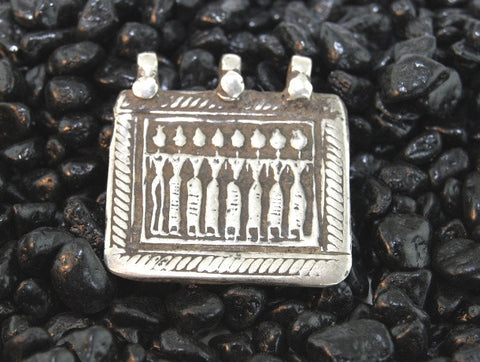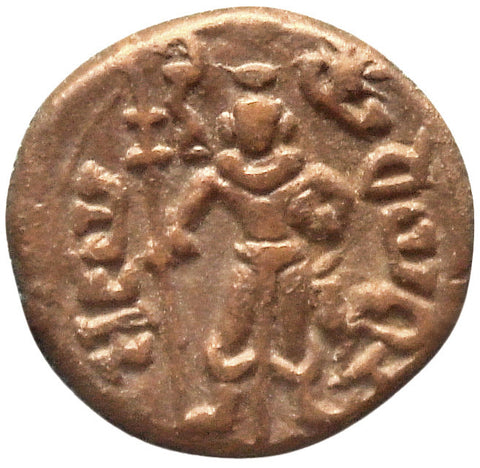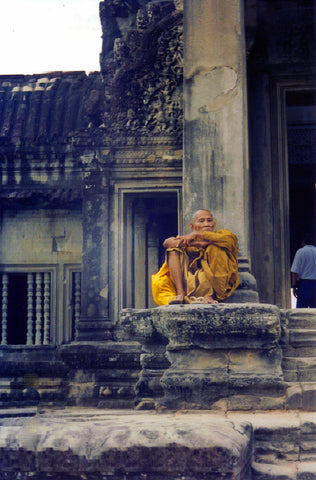Your Cart is Empty
Free Shipping for orders over $49 in Australia, $199 IN NEW ZEALAND/USA/CANADA AND $249 REST OF THE WORLD
Free Shipping for orders over $49 in Australia, $199 IN NEW ZEALAND/USA/CANADA AND $249 REST OF THE WORLD
Add description, images, menus and links to your mega menu
A column with no settings can be used as a spacer
Link to your collections, sales and even external links
Add up to five columns
Add description, images, menus and links to your mega menu
A column with no settings can be used as a spacer
Link to your collections, sales and even external links
Add up to five columns
The Hindu God Skanda - Indian Mythology in the 21st Century
by Linda Heaphy May 02, 2017

Protective amulet depicting Skanda and the Seven Mothers. Silver, early 20th century, southern India. Photo credit: Kashgar
While Ganesh is a well know and loved figure in Hindu mythology, his younger brother Skanda is almost completely forgotten.
Like many Hindu deities, Skanda has several names, including Murukan, Karttikeya, Kumara and Subrahmaya. Historically one of the most important deities in the Hindu pantheon of gods, he is now worshipped only in areas with Tamil influence, principally southern India, Sri Lanka and Malaysia.
Skanda was once venerated as the God of War and is the patron deity of Tamil Nadu. However, war-like characteristics are not his best loved features. Rather (and as befitting a brother of Ganesha), he is known for his graceful and handsome form and love of virtuous deeds. He represents the rising sun and the new year, and "never hesitates to come to the aid of a devotee when called upon in piety or distress". He is considered to be a brave and valiant warrior with a penchant for killing demons to save the innocent from harm.

Skanda (Murugan) depicted on a coin coin of the Yaudheya. 1st century BCE, Punjab. British Museum.
At the height of his popularity around 1000 AD, Skanda was adopted as the patron god of the ruling classes of India, largely because their power base was centred in the military castes. Interestingly, around this time Skanda also gained notoriety as the patron deity of thieves, an association that arose from his skill in entering the domain of the evil demon Taraka and his brothers in order to kill them. However, Skanda's popularity receded from 1500 AD onwards and his worship is today virtually unknown, except in south India where he continues to be venerated by all castes and at all levels of society.
According to the Mahabharata, Skanda was born under mysterious circumstances as the son of Shiva and Parvati, but was raised in infancy by the Seven Mothers, also known as the Seven Sisters or Septa Matrikas. In one version of the story, Indra, king of the demigods, heard a prophecy which stated that when Skanda achieved his adult powers, would go on to defeat Indra and alter the course of the coming war between the gods. To avoid this, Indra sought to kill Skanda while he was an infant. Shiva and Parvati sought to protect their son and engaged the Seven Mothers to raise and nurture him in secrecy. On learning of this, Indra made a counter-offer to the Mothers, suggesting to them that they arrange a fatal accident for the boy. Initially accepting Indra's proposal, the Mothers underwent a change of heart upon seeing the beautiful and virtuous boy. Their maternal instincts were evoked and instead of killing him, they adopted him as their beloved son, protecting him from harm until he grew into his powers and achieved his destiny.

Skanda depicted with his consorts on his Vahana peacock. Artist Raja Ravi Varma, 1848 - 1906. Photo credit: C. Cunniah & Co. Glass Merchants, India.
The story of the Seven Mothers is fascinating in its own right. They are believed to personify the seven stars of the constellation Pleiades, and were considered indispensable in assisting the great goddess Shakti Devi in her ongoing battles against demons. From the 9th century onwards they became a standard feature of temples dedicated to goddess cults throughout India. They represent the power of the origin of the earth, the evolving soul and the destruction of everything opposed to cosmic law. They also came to play a protective role in later centuries, particularly towards pregnant women and young children.
Skanda's vehicle or mount is the peacock which sometimes clutches a snake in its talons. He is depicted as a handsome young man and is associated with the colour red. He is frequently shown standing with his seven goddess foster mothers at his side, in a stylised form that dates directly back to the seals and symbols of the ancient Indus Valley civilisation which birthed him. Silver and gold amulet-plaques with this image are commonly worn today in southern India in order to protect the wearer from harm, even though the veneration of Skanda himself has long been abandoned.

Historical depiction of Skanda
References and Further Reading
Clothey, Fred W and Ramanujan, AK 1978. The Many Faces of Murukan: The History and Meaning of a South Indian God. Walter de Gruyter Publishers, Berlin New York
Sivananda, Sri Swami 1950. Lord Shanmukha and His Worship (reprinted 1996, World Wide Web Edition 2000). The Divine Life Society, India.
Fernando, Kishanie S 2001. A little bit of Scotland in Sri Lanka. Heritage Publication
Murugan Bhakti: The Skanda Kumara Website. Accessed May 2013.
Wikipedia 2008. Skanda.
2 Responses
Daniel egole
February 15, 2018
I want too get connected with the grand master
Leave a comment
Comments will be approved before showing up.
Also in Gods & Goddesses

Kali – A Most Misunderstood Goddess
by Linda Heaphy June 07, 2017
Beliefs And Customs British Raj Buddhism Demons Gods And Godesses Hinduism History India Religion Spirituality Tribal Customs
Read More
Saraswati - Hindu Goddess of Knowledge, Music and the Arts
by Linda Heaphy May 10, 2017
Beliefs And Customs Buddhism Gods And Godesses Hinduism India Indonesia Religion Saraswatti Spirituality
Read More
Tārā - A Beautiful Goddess For a Not So Beautiful World
by Linda Heaphy May 10, 2017
Beliefs And Customs Buddhism Gods And Godesses Hinduism India Nepal Religion Spirituality Tara Tibet
Read More Articles
About the Author
- Linda has a Honours degree in Marine Biology and a PhD in Ecology from the University of NSW, Australia. She has travelled extensively and is a passionate writer on subjects as diverse as the role played by women throughout history, tribal communities and their customs, symbology and ethnology, talismans and their history. Occasionally she also writes about her travel experiences, her new life on a 25 acres in the Northern Rivers region of northern Australia and her black miniature poodle Phoenix. She is currently writing her first book on talismans.
About Us
-
The Kashgar Philosophy

Kashgar began through a love of travel.
In 1989 my father Bernard packed in his house painting business and set off for two years on a backpacking trek to the remotest corners of the world. When he finally arrived in the oasis city of Kashgar, China, he was so impressed with its history that he decided to start a new life collecting and selling exotic goods from all over the world. For 2000 years the legendary city of Kashgar was a melting pot of ideas and a key trading post on the historic Silk Road. It was this unique combination of philosophy and trade that my father wanted to recreate at home.
Starting in markets in 1991, he opened his first store in the Sydney suburb of Newtown in 1994. I gave up my own career as a government scientist to join him in 2000 and soon convinced my partner Ian to join us in what was to become the Family Business.
Today our version of Kashgar stocks a hugely diverse range of furniture, rugs, textiles, antiques, handicrafts and jewellery sourced from over twenty different countries including India, Nepal, Tibet, China, Thailand, Burma, Laos, the Philippines, Vietnam, Mexico, Peru, Turkey, Palestine, Syria, Afghanistan and Turkmenistan. Our collection includes contemporary and tribal silver and gold jewellery, a unique range of headhunting curios, antique Buddhist relics and a collection of one-off necklaces, earrings and bracelets that I design and create myself using the beads and jewellery making techniques of ethnic minorities from around the globe.
Kashgar is a philosophy as well as a store. We are committed to supporting traditional artisans and small village communities by selling authentic handcrafted goods which are personally collected by us. By supporting traditional methods of design and production we hope to encourage local cottage industries which have a low impact on the environment and help ethnic minorities maintain their self-sufficiency into the 21st Century. We are particularly committed to assisting women around the world and to this end have worked with several organisations including the Hua Bin Women's Union of Vietnam, the East Timorese Women's Association and Tikondane in Zambia. Time honoured means of craftsmanship and traditional ways of life are disappearing as people all over the world give up their identity in favour of jeans and T-shirts. We see our trade as a means of staving off the inevitable encroachment of the 21st century, assisting communities to decide for themselves which parts of the western world they wish to incorporate (medicine, education) and which they wish to reject (prostitution, drug production, begging and servitude to warlords). We encourage our customers to think of the handicrafts and artifacts they buy from us as an investment: a piece of history and a way of life that may soon be gone forever.
Kashgar has recently closed its retail outlet and gone completely online.
In the past our pieces appeared in many movies including The Hobbit, Mission Impossible 2, Queen of the Damned, Scooby Doo, Moulin Rouge and Wolverine, and in many televisions series, as well as in plays, commercials and exhibitions. We've found special pieces for individual customers as well as for film sets, event management companies, hotels, businesses, consulates and embassies. The uniqueness of our stock means that we are also very appealing to interior and fashion designers with a taste for the exotic.
There is something for everyone at Kashgar - collectors, the curious, those looking for a special present or for something unique to adorn the home. Most of our items are one-off specialties; other pieces we only stock in small quantities so as to continuously offer a wide and ever-changing range of interesting products. We are also packed with ideas for decorating home and work premises that will challenge your established concepts of design and storage.

Please enjoy - Linda Heaphy
Become a Kashgar nomad and join our mailing list...
Sign up to get the latest on sales, new releases and more …



Nikhil Nanda
June 17, 2019
thanks for sharing such useful information